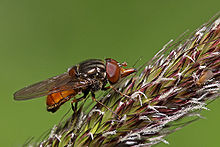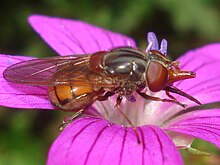
Summary
Rhingia campestris is a species of hoverfly, 7–11 millimetres (0.3–0.4 in) long, with a wingspan of 12–18 mm (0.5–0.7 in). It is common across the Palearctic from March until November. It has a broad orange abdomen with a black line along the sides (the black line is absent along the sides of Rhingia rostrata), and has the distinctive long snout of all Rhingia species. Rhingia campestris is the main pollinator for many plant species[2] and due to its long snout it can forage on tubulous flowers. Larvae are associated with cow dung. Adults males feed on nectar, while adult females feed on protein rich pollen, reflecting the cost of developing eggs.
| Rhingia campestris | |
|---|---|

| |
| male | |

| |
| female | |
| Scientific classification | |
| Domain: | Eukaryota |
| Kingdom: | Animalia |
| Phylum: | Arthropoda |
| Class: | Insecta |
| Order: | Diptera |
| Family: | Syrphidae |
| Genus: | Rhingia |
| Species: | R. campestris
|
| Binomial name | |
| Rhingia campestris Meigen, 1822
| |
| Synonyms [1] | |
Technical description edit
Description edit
External images
For terms see Morphology of Diptera
Wing length 5·5–7 mm Snout straight, longer than the diameter of the eye in side view. Tergites with black hind edge and side margins and often with a black mark in the middle of the tergite. Pre-genital sternite black-haired. Tibiae red.
See references for determination[3][4][5][6]
Distribution edit
Palearctic Fennoscandia South to the Pyrenees, Spain and the Mediterranean basin. Ireland East through Europe into European Russia and the Caucasus then to Siberia, Mongolia and the Russian Far East to the Pacific coast. [7][8]
Biology edit
Habitat: Wood and wetland occurring most frequently on land where cows are grazed. Can feed at pink flowers which have concealed nectar sources, making them unusable by other flies with less extended mouthparts.[9]
References edit
- ^ Stubbs, Alan E. & Falk, Steven J. (1983). British Hoverflies: An Illustrated Identification Guide. British Entomological & Natural History Society. p. 253, xvpp.
- ^ Van Der Kooi, C. J.; Pen, I.; Staal, M.; Stavenga, D. G.; Elzenga, J. T. M. (2015). "Competition for pollinators and intra-communal spectral dissimilarity of flowers". Plant Biology. 18 (1): 56–62. doi:10.1111/plb.12328. PMID 25754608.
- ^ Van Veen, M. (2004) Hoverflies of Northwest Europe: identification keys to the Syrphidae. 256pp. KNNV Publishing, Utrecht.addendum
- ^ Van der Goot,V.S. (1981) De zweefvliegen van Noordwest - Europa en Europees Rusland, in het bijzonder van de Benelux. KNNV, Uitgave no.32: 275pp. Amsterdam.
- ^ Bei-Bienko, G.Y. & Steyskal, G.C. (1988) Keys to the Insects of the European Part of the USSR, Volume V: Diptera and Siphonaptera, Part I. Amerind Publishing Co., New Delhi. ISBN 81-205-0080-6.
- ^ Coe, R.L. (1953) Diptera: Syrphidae. Handbks.ident.Br.insects, 10(1): 1-98. R.ent.Soc.London. pdf
- ^ Fauna Europaea
- ^ Peck, L.V. (1988) Syrphidae. In: Soos, A. & Papp, L. (eds.) Catalogue of Palaearctic Diptera, 8: 11-230. Akad.Kiado, Budapest.
- ^ Speight, M.C.D. (2011). "Species accounts of European Syrphidae (Diptera)" (PDF). Syrph the Net, the Database of European Syrphidae. 65: 285pp.


